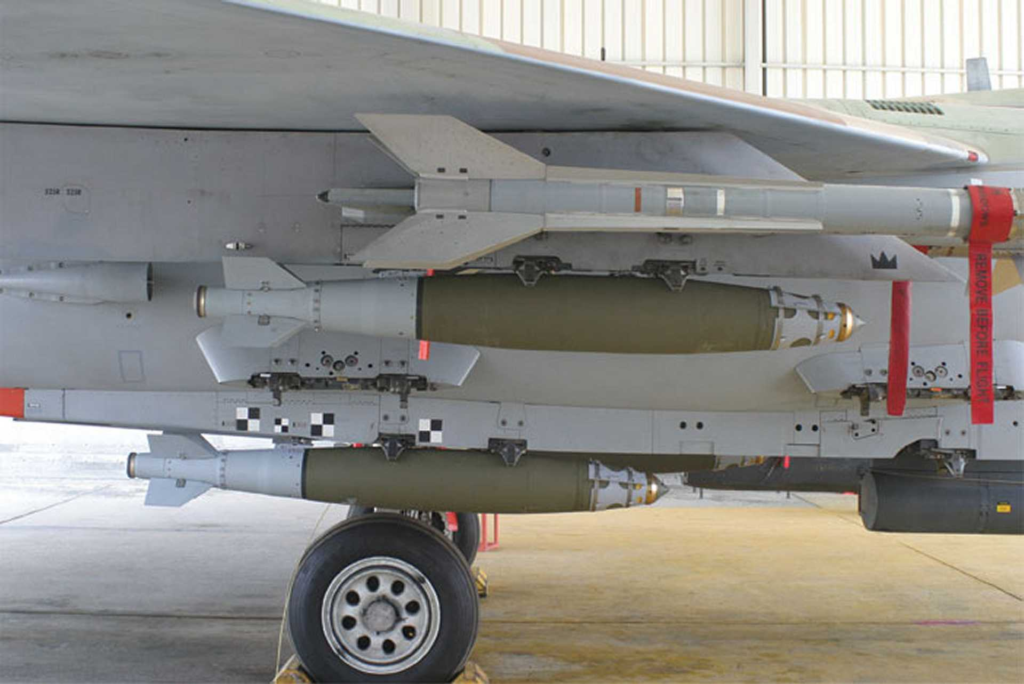On Friday, June 13, 2025, the Israeli Air Force executed a coordinated series of airstrikes against Iranian territory, focusing on the neutralization of key nuclear infrastructure sites. In this high-intensity operation, Israeli combat aircraft deployed one of the most destructive aerial munitions in the nation's conventional arsenal, the MPR-500, as reported by the Russian defense website Top War. This 227-kg precision-guided bomb is engineered to penetrate up to one meter of reinforced concrete or four layers of 0.2 m-thick reinforced concrete walls or floors, making it a formidable weapon against fortified installations.
Follow Army Recognition on Google News at this link
Israeli Air Force conducts high-precision bombing run using the MPR-500 against fortified Iranian targets. (Picture source: Elbit Systems)
The MPR-500, developed by Israeli defense company Elbit Systems and originally produced by Israel Military Industries, was designed for seamless integration with various Israeli Air Force combat platforms, including the F-15I Ra'am and F-16I Sufa multirole fighter aircraft. These platforms are capable of deploying the bomb with the Joint Direct Attack Munition kit, transforming the MPR-500 into a GPS-guided smart weapon. The bomb is also compatible with Paveway II and Lizard laser guidance systems, giving operators multiple targeting options in dynamic battlefield conditions.
What makes the MPR-500 particularly effective against infrastructure is its optimized penetration capability. Designed to maintain structural integrity during impact, it can perforate up to one meter of reinforced concrete or four layers of 200 millimeter reinforced concrete walls before detonation. This allows it to strike deep within fortified facilities, such as underground bunkers, missile silos, command centers, or nuclear enrichment installations. The straight-line penetration profile eliminates deviation from the target path, ensuring precise delivery even through complex layers of protection.
Beyond its penetration power, the MPR-500's effectiveness is enhanced by its controlled fragmentation design. Each bomb carries approximately 26,000 fragments engineered to spread uniformly upon detonation, maximizing lethality within a 2,200 square meter impact zone. This ensures critical internal systems, personnel, and secondary structures within hardened facilities are neutralized without the wide-area destruction typically associated with larger general-purpose bombs.
The MPR-500 is also designed with glide capabilities, allowing it to be released from stand-off distances and reach targets several tens of kilometers away. However, most of the Iranian targets struck on the night of June 13 were located deep within Iranian territory. This raises the critical question of whether Israeli combat aircraft penetrated Iranian airspace during the attack. Given the depth of the targets and reports that several Iranian air defense systems were neutralized prior to the strikes, it is plausible that Israeli aircraft executed deep-strike missions, a significant operational feat involving the suppression of enemy air defenses to secure access.
The guidance system of the MPR-500 plays a crucial role in enabling such precision. It is fully compatible with the Joint Direct Attack Munition kit, which incorporates an inertial navigation system combined with GPS for high-accuracy all-weather targeting. This modular kit transforms the bomb from a free-fall munition into a highly precise glide bomb. The JDAM guidance ensures that once the bomb is released, it autonomously navigates to the predesignated coordinates with minimal drift, achieving a circular error probable of less than 13 meters. This accuracy is vital for targeting infrastructure within dense or protected environments.
Additionally, the MPR-500 can also be fitted with laser guidance systems such as the Lizard and Paveway II kits. These systems allow real-time targeting adjustments by illuminating the target with a laser designator, either from the launching aircraft or a ground team. This guidance mode is particularly effective against mobile or last-minute targets and ensures flexibility in dynamic combat scenarios.
Despite its advanced capabilities, questions remain regarding the MPR-500’s suitability against Iran’s most deeply buried nuclear facilities. According to open-source data, the bomb’s penetration depth is limited to 1 to 1.5 meters of reinforced concrete. In contrast, the IAEA recently confirmed that Iran has relocated its primary nuclear infrastructure to depths of several hundred meters, effectively placing them beyond the reach of conventional bunker-busting munitions like the MPR-500.
This operational limitation does not diminish the bomb’s strategic value. The MPR-500 remains one of the most destructive conventional bombs in Israel’s military inventory. It was engineered to deliver a concentrated kinetic impact combined with fragmentation efficiency, making it ideal for neutralizing surface-to-medium hardened structures, disabling operations at secondary sites, and inflicting targeted infrastructure paralysis. In scenarios where precision and reduced collateral damage are imperative, few other munitions in Israel’s arsenal offer such a balance of power and control.
The deployment of this bomb during the latest Israeli strike operation reflects a strategic intent to degrade peripheral infrastructure, disrupt operational continuity, and deliver a calibrated deterrent message, rather than destroy Iran’s most secure nuclear assets outright. Army Recognition will continue to monitor this situation and provide exclusive, verified analysis on the evolving military and geopolitical landscape.






You must be logged in to post a comment.